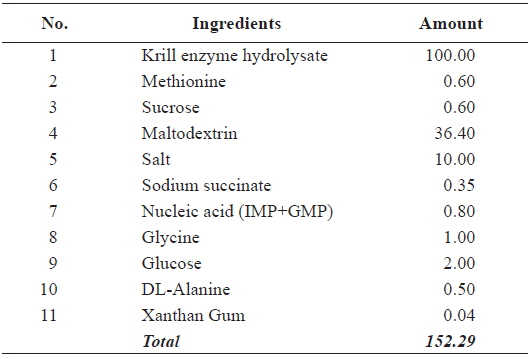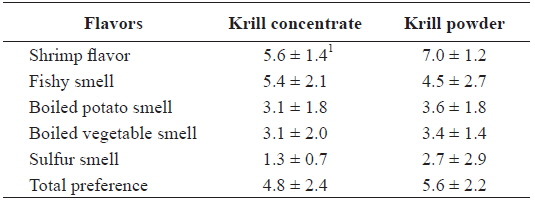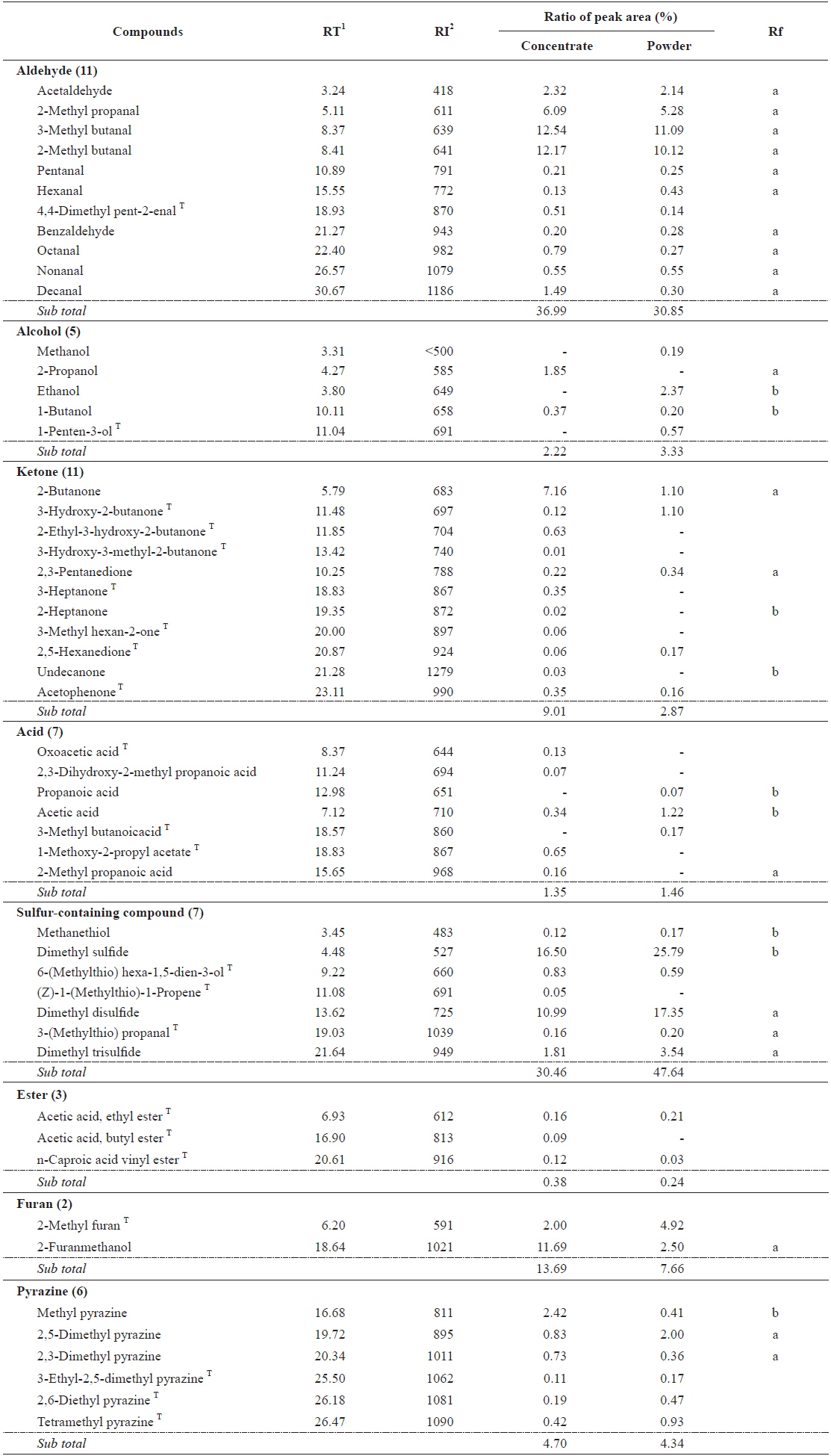



Antarctic krill
Antarctic krill is composed of 79.1% moisture, 13.1% protein, 4.0% lipids and 2.7% ash, chitin, and chitosan (Lee, 1999). It is a rich source of high-quality protein, with an estimated protein content of 60-65% by dry weight. Like other animal proteins, the protein derived from krill is complete, containing all nine of the essential amino acids required by humans. Krill also offers the advantage of being high in omega-3 polyunsaturated fatty acids (ω-3 PUFAs) such as eicosapentaenoic acid (EPA) and docosahexaenoic acid (DHA) (Tou et al., 2007). Techniques are needed for making krill palatable to humans; currently, most harvested krill is used only as fish bait.
Various studies have reported on krill’s composition and antioxidative activity (Kim et al., 2012); its application to Teriyaki sauce, soy sauce, and soybean paste and patties (Kim et al., 2013; Lee et al., 1984; Kim et al., 2009; Lee et al., 1985); and its fluoride content (Park et al., 1988). However, there has been little research on krill reaction flavor. Therefore, it is important to study this issue before using krill as an ingredient.
Generally, the term “process flavor” is used to define a group of flavors or flavoring ingredients that are produced from heating precursors. The reaction technique is usually used to produce meat and savory flavors (Manley, 1994). Studies on seafood reaction flavors from shrimp, tuna, and krill have been published. In particular, krill reaction flavor contains abundant sulfur-containing compounds, pyrazines and furans, yielding showing meaty and boiled flavors (Kim, 2011). However, studies on reaction flavor in seafood are challenging due to the foods’ fishy smell.
Ramen sauce is a typical seasoning in processed foods and provides the “ramen” taste. It is made with salt, seasonings (Korean paste powder, spices), and taste components that are extracted from natural materials and concentrated through drying. Ramen sauce has hot, salty, sweet, and savory qualities (Kim et al., 2001), and its composition may vary depending on the character of the ramen product (Kim et al., 2000). Ramen sauces with shrimp, beef, and chicken flavors are preferred abroad (KOTRA, 2005).
Although squid, mussels, sea tangles, and other seafood can be used in ramen sauces, the means of using still other seafood to enhance flavor need to be developed. Therefore, our objective was to develop a new ramen sauce with krill hydrolysate.
Fresh krill was obtained from Dong-won Ltd (Gimhae, Korea) and stored at –40℃. Alcalase (2.4 L, stored at 5℃ until use; Novo, Denmark) was used as an enzyme to hydrolyze of krill meat. Commercial ramen sauce was purchased at a local market in Busan, Korea, and used as a control.
>
Processing of krill hydrolysate
Frozen krill were thawed and combined with an equivalent amount of distilled water. Alcalase (1%) was added to and the mixture was fermented for 2 h at 55℃. The enzyme was deactivated by heating for 20-30 min at 90-100℃, after which the deactivated solution was filtered using an 80–mesh filter to obtain krill concentrate.
>
Processing of krill concentrate
Krill concentrate was amended with krill hydrolysate and 10 precursors according to the ratio shown in Table 1. The ratio was developed from previous research. Sodium succinate and nucleic acid were added to the solution to provide
[Table 1.] Recipe for making reaction flavor with krill enzyme hydrolysate

Recipe for making reaction flavor with krill enzyme hydrolysate
Krill powder was made with the ingredients indicated in Table 1, reacted at 100℃ for 40 min, and then sterilized. The solution was concentrated at 60℃ until it reached 50 brix. After concentration, a fluidized bed granulator was operated under the following conditions: granular temperature 80–90℃, inlet temperature 110℃, outlet temperature 60℃, drying time 8 min. Then powder temperature was reduced to below 50℃ by placing the powder at room temperature. Finally, it was filtered using a 12-mesh filter. To prepare samples for sensory evaluation, 3 g krill concentrate powder was mixed with 100 mL purified water and boiled at 95℃.
>
Application of krill reaction flavor to ramen sauce
Krill powder was selected for addition to the ramen sauce based on the results of the first sensory evaluation, which compared the krill concentrate and powder. Sample A comprised krill powder and commercial shrimp-flavored ramen sauce. Sample B was a control made of only commercial shrimp-flavored ramen sauce. Both samples were dissolved in water for sensory evaluation.
For sensory evaluation, 10 students of Pukyong National University were selected, trained, and given evaluation forms. The samples were evaluated using a 9-point hedonic scale, graded from 1 to 9 (no flavor to very strong flavor). Total preference was on a similar 1 to 9 scale (worst to best).
>
Measurement of headspace volatile compounds
Volatile compounds in samples were analyzed by GC/MSD. Total ion chromatograms of volatiles were obtained using a mass selective detector (Shimadzu QP-2010 plus, Japan) connected to a gas chromatograph (Shimadzu 2010, Japan). Tenax tubes were injected into the GC-MSD using the Auto Thermo Desorber 400 (Perkin Elmer, UK). A Tenax trap was thermally desorbed at 350℃ for 4 min, and the desorbed compounds were automatically injected into a capillary column (AT1 60 m × 0.32 mm × 1.0 μm). The oven temperature was programmed to shift from 35 to 120℃ at a rate 8℃/min, then from 120℃ to 80℃ at 12℃/min, and finally from 80℃ to 230℃ at 15℃/min. Helium was used a carrier gas. Volatile compounds were identified by comparing their molecular weights to standard molecular weights in the mass spectrum library.
>
Results of sensory evaluations of krill concentrate and powder
The results are shown in Table 2. The results were analyzed using an ANOVA and multiple comparisons test at a significance level of α = 0.05. Shrimp and sulfur flavor and total preference for krill powder were higher than for krill concentrate. Furthermore, smelled less fishy. The boiled potato and vegetable smells of the respective samples were similar. Considering overall preference, krill powder was selected for inclusion in the ramen sauce.
[Table 2.] Results of sensory evaluation between of krill concentrate and krill powder

Results of sensory evaluation between of krill concentrate and krill powder
>
Results of sensory evaluation of krill reaction flavor in ramen sauce
Comparisons of sensory evaluation of krill and commercial ramen sauces are shown in Table 3. Sample A was made with krill powder and ramen sauce. Sample B was the control, and was commercial shrimp-flavored ramen sauce. The fishiness and spiciness of the samples were similar. Shrimp flavor, an important characteristic, was stronger in sample B, but total preference was higher for sample A. These results imply that krill reaction flavor may enhance the flavor of ramen sauce.
[Table 3.] Results of sensory evaluation of sample A and sample B

Results of sensory evaluation of sample A and sample B
>
Identification of volatile compounds in krill concentrate and powder
The volatile compounds identified using headspace GC-MS are shown in Table 4. Each compound was identified from its peak and classified according to functional group. A total of 47 and 39 volatile compounds were identified in krill concentrate and powder respectively broken down as follows: for krill concentrate, 11 aldehydes. 11 ketones, 7 sulfur-containing compounds, 6 pyrazines, 5 acids, 3 esters and 2 furans; for krill powder, 11 aldehydes, 6 sulfur-containing compounds, 6 pyrazines, 5 ketones, 4 alcohols, 3 acids, 2 esters and 2 furans. Of all compounds identified, aldehydes were the most common in both samples.
[Table 4.] Identification of volatile compounds in krill concentrate and krill powder

Identification of volatile compounds in krill concentrate and krill powder
Aldehydes play an important role in the overall flavor of dry-cured meat products (Wang et al., 2012) and have pungent smell (Shahidi, 1989). Aldehydes were quantitatively a abundant in both krill concentrate and powder. Among these aldehydes, 3-methyl butanal had the highest peak and pentanal had the lowest. The flavors typically associated with 3-methyl butanal are spicy, chocolate-like, and crab flavors (Neeter and de Jong, 1992; Chen and Zhang, 2006) while 2-butanal, which had the second highest peak in both samples, is characterized by a wine flavor. Both 3-methyl butanal and 2-methyl butanal are generated from sugar fermentation (El-sayed et al., 2005). Straight-chain aldehydes, such as pentanal, hexanal, octanal, nonanal and decanal were also detected; these are characterized by green grass-like and other herbaceous aromas (Moio et al.,1993) and are widely reported in seafood such as crab, squid, prawn, crayfish, and sardine (Chen et al., 2006). Furthermore, benzaldehyde, which has an almond or peanut-like flavor, was also detected (Collin et al., 1993), and is another important volatile compound in seafood (Chung and Cadwallader, 1993). Aldehydes in the krill extract declined from 36.99% to 30.85% during the freeze-drying process because of decreases in 2-methyl propanal, 3-methyl butanal and 2-methyl butanal. However, the reduction of these compounds was low, with threshold values as low as 0.1 ppb, and therefore it probably affected the flavor.
Low levels of alcohols were detected in the samples. Ethanol showed the highest peak while methanol showed the lowest. Alcohols did not affect the flavor because of their high threshold values. Seven kinds of acid were detected, and provided a pungent smell or refreshing aroma depending on the type, but they were too scarce to affect the flavor. Esters had no effect for the same reason.
Ketones have been reported to contribute sweetness to boiled crustaceans as oxidation compounds of polyunsaturated fatty acids (Cha et al., 1992). Among ketones in krill extract, 2-butanone showed the highest peak area (7.16%), but it declined to 1.10% in krill powder. Despite this discrepancy, there was no effect on flavor because the threshold value was 5,000 ppb.
Seven sulfur-containing compounds were detected in the samples, six of which were found in krill powder. Sulfur-containing compounds play an important role in generating the meaty aroma of many meat products. Sulfur-containing compounds are thought to be generated through Strecker degradation of methionine added to samples. They have been reported to be the key aroma compounds in meat and cheeses (Werkhoff et al., 1990; Mottram, 1991; Engels et al., 1997). Sulfurcontaining compounds were one of the most abundant types in this study, and their levels were 17.18% higher in krill powder than in krill concentrate. These compounds contribute to the meaty flavor that led to the high preference scores during sensory evaluation. Dimethyl sulfide, dimethyl disulfide and dimethyl trisulfide, which provide sulfury and cabbage like flavors (Fors, 1983), showed high peaks and increased during the freeze-drying process in krill powder. This resulted in the greater boiled-potato, boiled-vegetable, sulfury and fishy flavors of the krill powder vs. the concentrate.
Furans are the main volatile compounds of crustaceans (Lee et al., 2007). Furans such as 2-methyl furan and 2-furanmethanols were detected in this study; they likely originate from the Maillard reaction, and add a sweet sensation to food (Fors, 1983). Crab and fish sauce also have trace amounts of 2-methyl furan, which contributes to the characteristic aroma of crustaceans and fish. The level of 2-furanmethanol was 9.19% higher in the krill concentrate than in the powder; this volatile compound was likely generated via Strecker degradation of sugar dehydration during processing (Heath and Reineccius, 1986).
Although present only in small amounts, various pyrazines were detected, including methyl pyrazine, 2,5-dimethyl pyrazine, 2,3-dimethyl pyrazine, 3-ethyl-2,5-dimethyl pyrazine, 2,6-diethyl pyrazine and tetramethyl pyrazine. Pyrazines are mainly detected from shrimp (Kubota, 1988), provide a desirable popcorn aroma to food and are formed from the Maillard reaction (Fors, 1983). The importance of pyrazines to the overall aroma of roasted foods has been well established (Maga, 1982).



